
Concept explainers
Classify each terpene and terpenoid in Problem 30.28 (e.g., as a monoterpene, sesquiterpene, etc.).
(a)
Interpretation: The terpene and terpenoid are to be classified as monoterpene, sesquiterpene, etc.
Concept introduction: Terpenes are naturally occurring compounds that are present in plants and animals. Terpenes contain one or more isoprene units. Terpenoids are derivatives of terpenes with oxygen containing functional group such as carbonyl groups. Monoterpenes contain two isoprene units, sesquiterpene contain three isoprene units etc.
Answer to Problem 30.29P
Neral is classified as monoterpene.
Explanation of Solution
The structure of isoprene is,

Figure 1
The isoprene unit contains four carbon atoms in the long chain and one carbon atom in branch. Isoprene unit in a terpene consists of carbon-carbon sigma or pi bonds.
The isoprene units in the given compound are shown below.
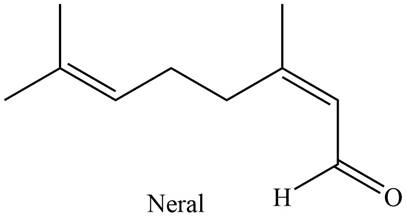
Figure 2
The highlighted bonds represent the isoprene unit. There are two isoprene units present in the given compound. Neral is classified as monoterpene.
Neral is classified as monoterpene.
(b)
Interpretation: The terpene and terpenoid are to be classified as monoterpene, sesquiterpene, etc.
Concept introduction: Terpenes are naturally occurring compounds that are present in plants and animals. Terpenes contain one or more isoprene units. Terpenoids are derivatives of terpenes with oxygen containing functional group such as carbonyl groups. Monoterpenes contain two isoprene units, sesquiterpene contain three isoprene units etc.
Answer to Problem 30.29P
Carvone is classified as monoterpene.
Explanation of Solution
The structure of isoprene is,

Figure 1
The isoprene unit contains four carbon atoms in the long chain and one carbon atom in branch. Isoprene unit in a terpene consists of carbon-carbon sigma or pi bonds.
The isoprene units in the given compound are shown below.
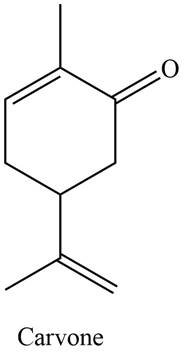
Figure 3
The highlighted bonds represent the isoprene unit. There are two isoprene units present in the given compound. Carvone is classified as monoterpene.
Carvone is classified as monoterpene.
(c)
Interpretation: The terpene and terpenoid are to be classified as monoterpene, sesquiterpene, etc.
Concept introduction: Terpenes are naturally occurring compounds that are present in plants and animals. Terpenes contain one or more isoprene units. Terpenoids are derivatives of terpenes with oxygen containing functional group such as carbonyl groups. Monoterpenes contain two isoprene units, sesquiterpene contain three isoprene units etc.
Answer to Problem 30.29P
Lycopene is classified as tetraterpene.
Explanation of Solution
The structure of isoprene is,

Figure 1
The isoprene unit contains four carbon atoms in the long chain and one carbon atom in branch. Isoprene unit in a terpene consists of carbon-carbon sigma or pi bonds.
The isoprene units in the given compound are shown below.

Figure 4
The highlighted bonds represent the isoprene unit. There are eight isoprene units present in the given compound. Lycopene is classified as tetraterpene.
Lycopene is classified as tetraterpene.
(d)
Interpretation: The terpene and terpenoid are to be classified as monoterpene, sesquiterpene, etc.
Concept introduction: Terpenes are naturally occurring compounds that are present in plants and animals. Terpenes contain one or more isoprene units. Terpenoids are derivatives of terpenes with oxygen containing functional group such as carbonyl groups. Monoterpenes contain two isoprene units, sesquiterpene contain three isoprene units etc.
Answer to Problem 30.29P
The
Explanation of Solution
The structure of isoprene is,

Figure 1
The isoprene unit contains four carbon atoms in the long chain and one carbon atom in branch. Isoprene unit in a terpene consists of carbon-carbon sigma or pi bonds.
The isoprene units in the given compound are shown below.

Figure 5
The highlighted bonds represent the isoprene unit. There are eight isoprene units present in the given compound. The
The
(e)
Interpretation: The terpene and terpenoid are to be classified as monoterpene, sesquiterpene, etc.
Concept introduction: Terpenes are naturally occurring compounds that are present in plants and animals. Terpenes contain one or more isoprene units. Terpenoids are derivatives of terpenes with oxygen containing functional group such as carbonyl groups. Monoterpenes contain two isoprene units, sesquiterpene contain three isoprene units etc.
Answer to Problem 30.29P
Patchouli alcohol is classified as sesquiterpene.
Explanation of Solution
The structure of isoprene is,

Figure 1
The isoprene unit contains four carbon atoms in the long chain and one carbon atom in branch. Isoprene unit in a terpene consists of carbon-carbon sigma or pi bonds.
The isoprene units in the given compound are shown below.

Figure 6
The highlighted bonds represent the isoprene unit. There are three isoprene units present in the given compound. Patchouli alcohol is classified as sesquiterpene.
Patchouli alcohol is classified as sesquiterpene.
(f)
Interpretation: The terpene and terpenoid are to be classified as monoterpene, sesquiterpene, etc.
Concept introduction: Terpenes are naturally occurring compounds that are present in plants and animals. Terpenes contain one or more isoprene units. Terpenoids are derivatives of terpenes with oxygen containing functional group such as carbonyl groups. Monoterpenes contain two isoprene units, sesquiterpene contain three isoprene units etc.
Answer to Problem 30.29P
Periplanone B is classified as sesquiterpene.
Explanation of Solution
The structure of isoprene is,

Figure 1
The isoprene unit contains four carbon atoms in the long chain and one carbon atom in branch. Isoprene unit in a terpene consists of carbon-carbon sigma or pi bonds.
The isoprene units in the given compound are shown below.
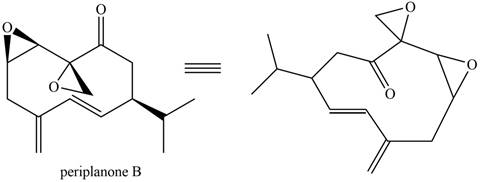
Figure 7
The highlighted bonds represent the isoprene unit. There are three isoprene units present in the given compound. Periplanone B is classified as sesquiterpene.
Periplanone B is classified as sesquiterpene.
(g)
Interpretation: The terpene and terpenoid are to be classified as monoterpene, sesquiterpene, etc.
Concept introduction: Terpenes are naturally occurring compounds that are present in plants and animals. Terpenes contain one or more isoprene units. Terpenoids are derivatives of terpenes with oxygen containing functional group such as carbonyl groups. Monoterpenes contain two isoprene units, sesquiterpene contain three isoprene units etc.
Answer to Problem 30.29P
Dextropimaric acid is classified as diterpene.
Explanation of Solution
The structure of isoprene is,

Figure 1
The isoprene unit contains four carbon atoms in the long chain and one carbon atom in branch. Isoprene unit in a terpene consists of carbon-carbon sigma or pi bonds.
The isoprene units in the given compound are shown below.
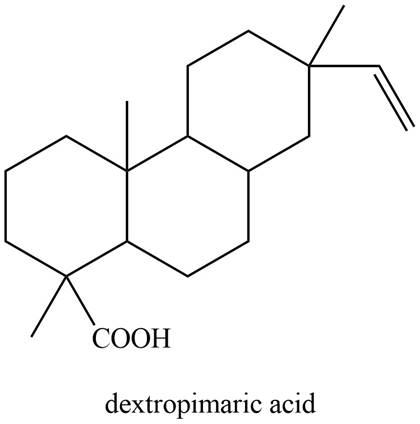
Figure 8
The highlighted bonds represent the isoprene unit. There are four isoprene units present in the given compound. Dextropimaric acid is classified as diterpene.
Dextropimaric acid is classified as diterpene.
(h)
Interpretation: The terpene and terpenoid are to be classified as monoterpene, sesquiterpene, etc.
Concept introduction: Terpenes are naturally occurring compounds that are present in plants and animals. Terpenes contain one or more isoprene units. Terpenoids are derivatives of terpenes with oxygen containing functional group such as carbonyl groups. Monoterpenes contain two isoprene units, sesquiterpene contain three isoprene units etc.
Answer to Problem 30.29P
The
Explanation of Solution
The structure of isoprene is,
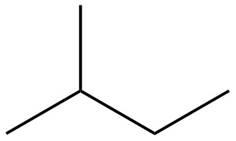
Figure 1
The isoprene unit contains four carbon atoms in the long chain and one carbon atom in branch. Isoprene unit in a terpene consists of carbon-carbon sigma or pi bonds.
The isoprene units in the given compound are shown below.
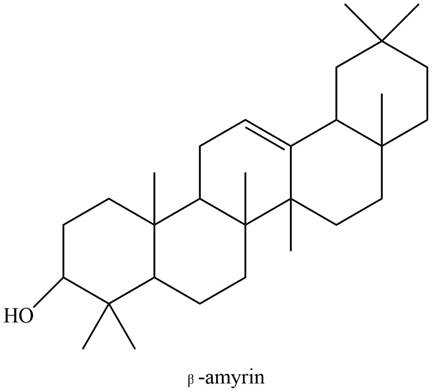
Figure 9
The highlighted bonds represent the isoprene unit. There are four isoprene units present in the given compound. The
The
Want to see more full solutions like this?
Chapter 30 Solutions
Organic Chemistry-Package(Custom)
- Be sure to answer all parts. Draw the structure corresponding to each IUPAC name. a. 6-ethyl-2-octyne I I 1 I -CH₂ I I H₂C edit structure... b. 5,6-dimethyl-2-heptyne I I I I I draw structure...arrow_forwardShow how to convert propene to this compound , using any inorganic reagents as necessary. Q.) Propanonearrow_forwardHow many monochloro substitution products are produced when the alkane below is chlorinated? Consider both constitutional isomers and stereoisomers. or a.) b.) c.) a.) The number of monochloro substitution products is b.) The number of monochloro substitution products is c.) The number of monochloro substitution products isarrow_forward
- Q9. The following structure represent a hydroxylated product of head-to-tail dimer of two isoprene units. This product is A. menthol B. camphor. C. linalool D. thymol Q10. The threshold of a chemical compound as odorant in perfumery is determined by (name four): 1... 2... 3. 4.arrow_forward3. Each of the following compounds contains two carbonyl groups. Identify which carbonyl group will exhibit a signal at lower wavenumber.arrow_forwardShow how to convert propene to this compound , using any inorganic reagents as necessary. Q.) Propanearrow_forward
- What are the products of ozonolysis of the following unsaturated hydrocarbon? * Products 义,. ,文 , B. H. H. H. 。又 人, H. H. H. H. D. H. H. H. 文,。 H. H. H. H. Oarrow_forward(Organic chemistry) Fill in the missi starting materials or reagentsarrow_forwardC. D. B. 1) Give the major organic product of the following reaction. Don't forget stereochemistry in certain cases. 2) Assign the reaction as addition, elimination, substitution, or rearrangement. A. D D 1. H₂O/Hg(OAC) 2 2. NaBH4 Br₂ CCl4 (inert solvent) H₂/Pd/C HBr Type of Reaction: Type of Reaction: Type of Reaction: Type of Reaction:arrow_forward
- Please fill out the entire chart and name the molecules present following IUPAC List All Functional Group(s) in order If 22 pi bonds is it isolated or Molecule # of each type Unit(s) of Unsaturation of Priority If alkyl halide, alcohol or amine label as 1°, 2°, 3°, 4° If cyclic, alkene or benzene, what type of substitution? (mono, di tri, tetra..AND all of the following that apply: E/Z, geminal/vicinal, cis/trans, ortho, meta, of carbons conjugated? para) 1° = 2° = 3° = 4° `Br 1° = CN 2° 3° ° = 4° = Br O 1° = 2° 3° = 4° 1° = 2° = 3° = 4° 1° = 2° = он 3° = но. 4° = 1° = 2°3= 3° 4° =arrow_forwardShow how to convert propene to this compound , using any inorganic reagents as necessary. Q.) Propanoic acidarrow_forwardQuestion 11 For the following sequence, fill in any missing reagents/products. تیس سال PhyP.. KOIBu HO OH 4 cat. H₂SO4 NaBHarrow_forward
 ChemistryChemistryISBN:9781305957404Author:Steven S. Zumdahl, Susan A. Zumdahl, Donald J. DeCostePublisher:Cengage Learning
ChemistryChemistryISBN:9781305957404Author:Steven S. Zumdahl, Susan A. Zumdahl, Donald J. DeCostePublisher:Cengage Learning ChemistryChemistryISBN:9781259911156Author:Raymond Chang Dr., Jason Overby ProfessorPublisher:McGraw-Hill Education
ChemistryChemistryISBN:9781259911156Author:Raymond Chang Dr., Jason Overby ProfessorPublisher:McGraw-Hill Education Principles of Instrumental AnalysisChemistryISBN:9781305577213Author:Douglas A. Skoog, F. James Holler, Stanley R. CrouchPublisher:Cengage Learning
Principles of Instrumental AnalysisChemistryISBN:9781305577213Author:Douglas A. Skoog, F. James Holler, Stanley R. CrouchPublisher:Cengage Learning Organic ChemistryChemistryISBN:9780078021558Author:Janice Gorzynski Smith Dr.Publisher:McGraw-Hill Education
Organic ChemistryChemistryISBN:9780078021558Author:Janice Gorzynski Smith Dr.Publisher:McGraw-Hill Education Chemistry: Principles and ReactionsChemistryISBN:9781305079373Author:William L. Masterton, Cecile N. HurleyPublisher:Cengage Learning
Chemistry: Principles and ReactionsChemistryISBN:9781305079373Author:William L. Masterton, Cecile N. HurleyPublisher:Cengage Learning Elementary Principles of Chemical Processes, Bind...ChemistryISBN:9781118431221Author:Richard M. Felder, Ronald W. Rousseau, Lisa G. BullardPublisher:WILEY
Elementary Principles of Chemical Processes, Bind...ChemistryISBN:9781118431221Author:Richard M. Felder, Ronald W. Rousseau, Lisa G. BullardPublisher:WILEY





